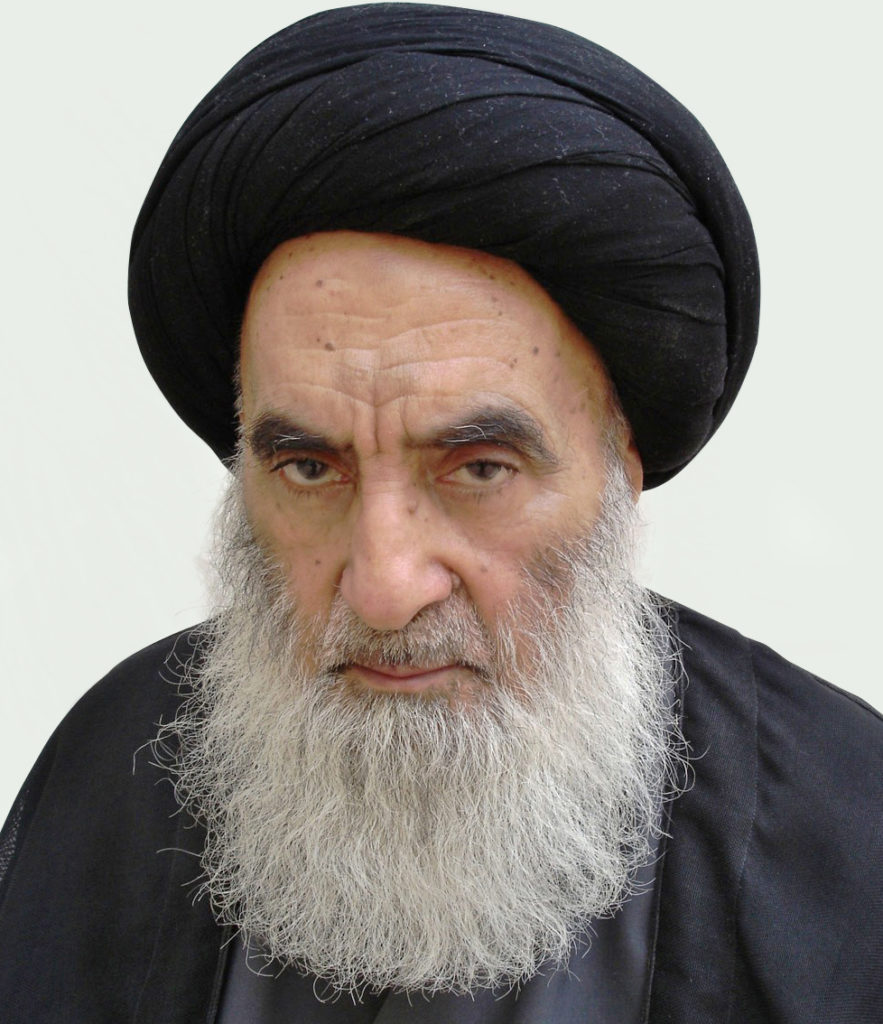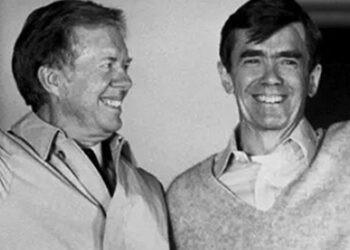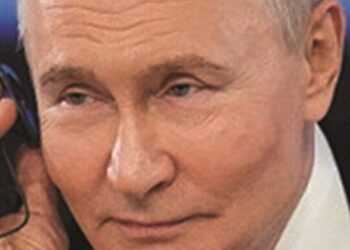February 28, 2020

With the assassination of Maj. Gen. Qassem Soleymani and the Iraqi who led the Iraqi militias sponsored by Iran, those militias are now leaderless and two competing clerics—Iran’s Supreme Leader Ali Khamenehi and Iraq’s Shiite leader Ayatollah Ali Sistani—are now each trying to bend the militias to their command.

Dozens of Iraqi militias, some that have long bowed to Khamenehi and others that are responsive to Sistani, are linked together in a paramilitary grouping called the Hashd al-Shaabi. But the Khamenehi loyalists have long predominated and responded to Soleymani’s direction.

Now, the Sistani-led religious authority based in Iraq’s Najaf is using the power vacuum to assert its own influence, and seize the powerful paramilitary umbrella group’s levers of power.
The tussle for power began seven weeks ago, with the killing of Hashd al-Shaabi leader Abu Mahdi al-Muhandis who was in the same car with Soleymani when they were struck by a US drone in Baghdad.
Soon after, the pro-Iran factions in the paramilitary nominated one of their leaders to be the chief of staff and director of operations for the Popular Mobilization Authority (PMA), the body that oversees the Hashd al-Shaabi, and succeed Muhandis.
Such a move was expected. However, factions associated with Najaf threatened to withdraw from the PMA if the government did not work to limit Iranian influence within the body, several Shiite commanders told the Middle East Eye.
Sistani himself was responsible for encouraging the Hashd al-Shaabi’s formation in the first place, by issuing a fatwa in 2014 calling on Iraqis to mobilize and volunteer to fight the Islamic State, who at that time had seized almost a third of Iraq.
That sparked the mobilization of dozens of armed groups, which coalesced alongside older factions to create the Hashd al-Shaabi umbrella group, a governmental organization protected by law.
Iranian-backed factions, such as the Badr Organization, Asaib Ahl al-Haq and Kataeb Hezbollah, are the most powerful groups under the PMA. But the Hashd al-Shaabi’s true legitimacy lies with Sistani’s fatwa.
Analysts have suggested if forces linked to Sistani withdraw, the Iran-backed groups remaining will lose their ability to repel local and international criticism, and accusations of humanitarian abuses and wide-scale corruption.
“Najaf seeks to limit the penetration of Qom’s arms into Iraqi government institutions, in an attempt to distance Iraq from regional and international conflicts. So, this is part of the ongoing struggle between Qom and Najaf,” Iraqi analyst Abdulwahid Tuama told Middle East Eye.
“[Sistani] sees the vacuum created after the Soleymani and Muhandis’s killings as a great opportunity to regain control of an important military institution and extract it from the hands of leaders who believe in Velayat-e Faqih [clerical rule by Khamenehi], returning it to Iraqi authority in the process.”
Muhandis was considered Iran’s point man in Iraq, and was granted singularly broad powers by Khamenehi and Soleymani to make important decisions.
Apart from founding many pro-Iran Hashd al-Shaabi factions, he also held the position of PMA deputy chairman until last September.
Muhandis used the financial and human resources of the authority to tighten his control over the factions and subject them to his influence. Although an Iraqi government decision abolished his position and stripped him of any official financial or administrative powers five months ago, he remained in control of most of the PMA’s forces and directorates up until his death.
Regaining control of the PMA and its forces, especially those loyal to Iran, was one of the biggest challenges facing both the governments of former Iraqi Prime Ministers Haider al-Abadi and Adel Abdul Mahdi in the last six years.
Attempts at reform aimed at bringing the Hashd al-Shaabi under control of the central government were repeatedly blocked by Muhandis and Soleymani.
The killing of the pair at the same time—and the inability of the Iranians to replace them with figures with the same leadership skills—has loosened Iran’s grip on the PMA and created room for leaders loyal to Najaf to fill the void, Hashd al-Shaabi commanders told Middle East Eye.
Fearing “the outbreak of Shia-Shia fighting,” Najaf has largely stayed quiet about Iran’s domination of the body, commanders said. But Middle East Eye said that is no longer true.
A delegation headed by prominent Sistani representative Sayyed Ahmed al-Safi and leaders of the four largest armed factions loyal to Najaf—the Abu al-Fadhl al-Abbas Division, the Imam Ali Division, the Inssar al-Marjiyaa Brigade and the Ali al-Akbar Brigade—have met with PMA chief Faleh al-Fayyadh to issue their demands.
According to two commanders who attended the meeting with Fayyadh, among the demands submitted was a list of top positions the delegation wants filled by Najaf-backed leaders.
The list includes: secretary of the commission, the second most powerful financial and administrative position; assistant chief of staff for operations, the figure tasked with managing military operations; the reserve forces manager, which oversees fighters linked to holy shrines and religious guidance; and the leadership of operations in the Middle Euphrates, Ramadi and Mosul regions.
“We are trying to get things back to normal,” one of the attendees told Middle East Eye.
According to the attendee, the PMA needed to be pro-Iraq first and foremost, and the Hashd al-Shaabi “should be exclusively subject to the Iraqi leadership, away from corruption, economic gains and regional agendas.”
“We believe that this is the right time. We can do it now and we will do it,” he said.
As head of the Qods Force, Soleymani was responsible for Iranian field operations in the Middle East, but the reliance on his considerable personal skills and relations with faction leaders has made it difficult to find a replacement.
To overcome the vacuum left by Soleymani’s death, the Pasdaran have redistributed the tasks that he was working on, “until the final decision regarding the nomination of the person in charge of each task is made by Khamenehi,” a prominent Iraqi Shiite commander close to the Pasdaran told Middle East Eye.
According to the new instructions, the Syria portfolio was handed to President Rohani, the Lebanon file to Hassan Nasrallah, the Lebanese leader of the Hezbollah, while Iraq’s political portfolio has gone to the Iranian ambassador in Baghdad, Hassan Danaei-Far and the military portfolio was handed to Hamid Abdallahi, commander of the Qods Force special operations unit and Soleymani’s former aide in Iraq.
The moves by Sistani loyalists have not gone down well in Tehran. “The Iranians have informed a number of faction leaders that they will not pay any money or [give any] weapons to any of the factions anymore,” the commander told Middle East Eye, in an obvious effort to bring them to heel.
He added that they had been told to steer clear of any physical confrontation with US assets in Iraq, and stick to applying political pressure where possible instead.
“Unfortunately, the state of fragmentation and chaos now experienced by the factions is the worst since they were established,” he said. ”Some of them have begun to witness internal splits.”
In an attempt to heal the rift left by Muhandis’s death, Iran-backed Hashd al-Shaabi leaders formed a seven-member committee tasked with taking urgent decisions, the Eye reported.
The committee tasked itself with reevaluating the PMA’s priorities, re-deploying forces and parceling out the directorates that were personally managed by Muhandis, two members of the committee told Middle East Eye.
The most important task, they said, was deciding who will succeed Muhandis, serve as Hashd al-Shaabi’s chief of staff and maintain Iranian control over the PMA.
The seven-member committee included Abu Fadak, secretary-general of Kataeb Hezbollah, Abu Ali al-Basri, head of PMA operations and one of the Badr Organization’s leaders, Abu Jaafar al-Assadi, leader of Jund al-Imam Brigades, Abu Alaa al-Walai, head of Sayyid al-Shuhada Brigades, Laith Khazali, as a representative of Asaib Ahl al-Haq, Abu Iman al-Bahli, intelligence chief of the PMA, and Abu Muntazir al-Husayni, security advisor to the Iraqi prime minister. (The bolded groups are Iranian-sponsored.)
The committee chose Abu Fadak as Muhandis’s heir.
The real name of Abu Fadak—known as the “uncle”—is not publicly known. But he has been prominent ever since joining the founding core of Kataeb Hezbollah fighters back in 1997, which carried out operations against Saddam Hussein’s government from the marshes of southern Iraq.
He was close to Muhandis and is known for his military prowess, confidence and tribal affiliations. He is also an adherent to Velayat-e Faqih “and does not move without a fatwa,” a member of the committee said.
According to an Asaib Ahl al-Haq commander, leaders of the armed factions had been anxious that the “chaos” following Muhandis’s death could have meant the “disintegration and the end of the Hashd al-Shaabi,” which is why they were keen to quickly unite around Abu Fadak.
“Abu Fadak is strong and a true leader with honorable positions and good relations with all,” he said. “We all chose him, and Sayyed Khamenehi has supported our option.”
Despite the optimism over Abu Fadak’s appointment, the pro-Iran factions still face an uncertain future.
The Najaf-backed factions’ threat to withdraw from the Hashd al-Shaabi and regularize under the Iraqi Defense Ministry or form an independent body tasked with protecting holy shrines has swung open the door for fighters to defect from Iranian-aligned groups, Middle East Eye said.
Many Sistani loyalists are already enlisted in Iran-backed factions, which promised them better organization and better pay. But newly regularized Najaf-aligned factions could now offer that as well. This would strip the Iranian-backed factions of their most attractive point amid constant calls to demobilize their fighters and dissolve the PMA following the defeat of the Islamic State, commanders told Middle East Eye.
“The withdrawal of the pro-Sistani factions would embarrass everyone and push everyone into a corner, including the Iraqi government,” said a senior national security official.
“The remaining forces will be the factions associated with Khamenehi, which have no legal or religious cover that legitimizes their activities inside Iraq or guarantees continued funding from the Iraqi government,” he added.
“Once Sistani raises his hand from the PMA, its purpose is no longer valid, and it must be abolished and its associated forces demobilized.”














